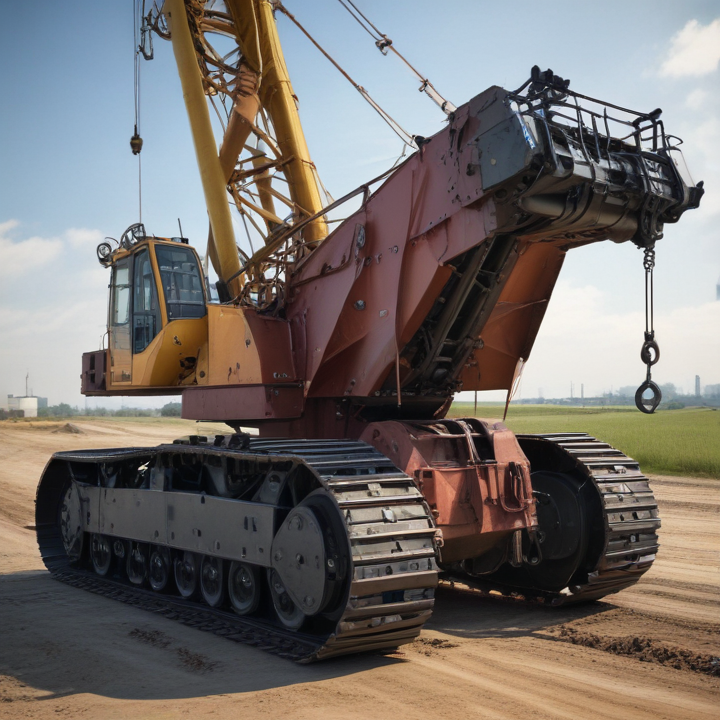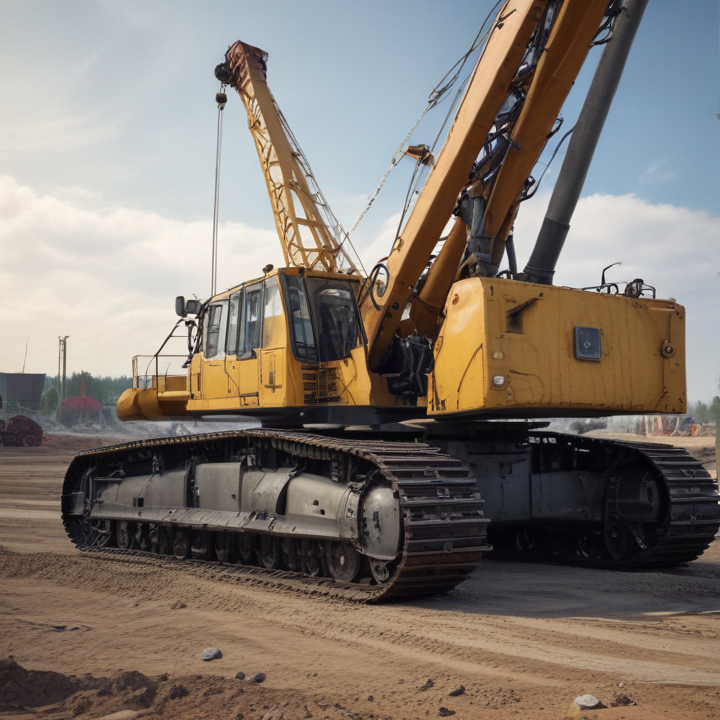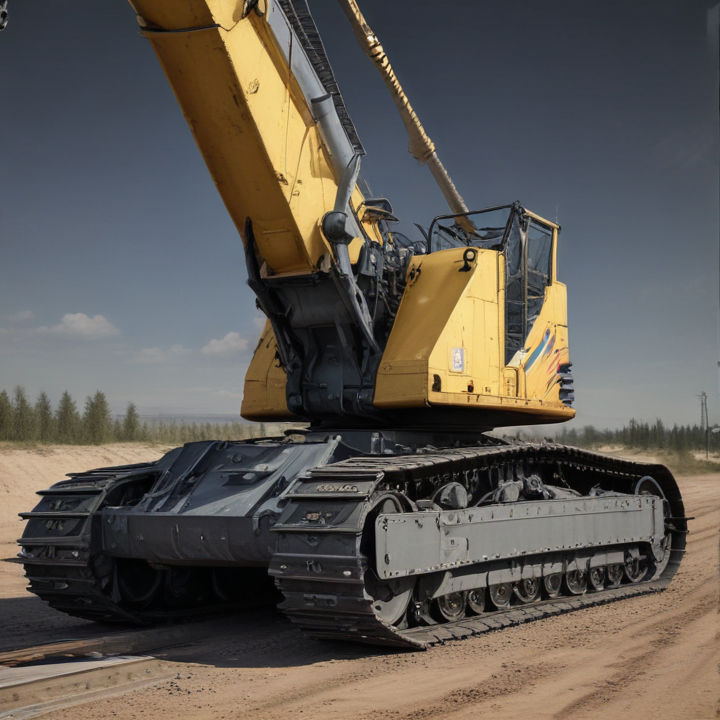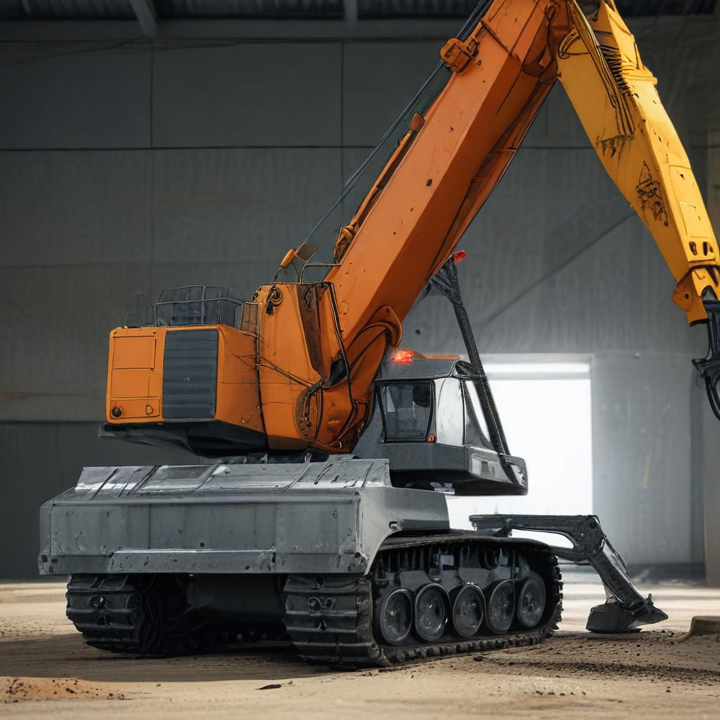crawler crane Safety Certifications
Crawler crane safety certifications are crucial to ensure safe operation, compliance with regulations, and to minimize risks on construction sites. The key safety certifications for crawler cranes generally include:
1. OSHA (Occupational Safety and Health Administration):
– OSHA sets and enforces standards to ensure safe working conditions. Certification under OSHA’s guidelines demonstrates that crawler crane operations meet federal safety requirements. OSHA 29 CFR 1926 Subpart CC outlines specific standards for crane operation.
2. ANSI (American National Standards Institute) / ASME (American Society of Mechanical Engineers):
– ANSI/ASME standards, particularly ASME B30.5 for mobile and locomotive cranes, provide comprehensive safety guidelines for the design, inspection, testing, maintenance, and operation of crawler cranes. Compliance indicates adherence to nationally recognized safety standards.
3. NCCCO (National Commission for the Certification of Crane Operators):
– The NCCCO provides certification programs for crane operators, which include written and practical exams. Being certified by NCCCO ensures that the operators have the necessary skills and knowledge to safely operate crawler cranes.
4. CPCS (Construction Plant Competence Scheme):
– In the UK, the CPCS provides certification to operators who prove their competence through practical and theoretical assessments. This scheme is widely recognized and ensures high safety and skill levels.
5. ISO (International Organization for Standardization):
– ISO 9927-1 outlines standards for the inspection and maintenance of cranes. Adhering to ISO standards ensures international best practices in crane safety.
6. Manufacturer Training and Certification:
– Many crane manufacturers offer specific training programs and certifications for their equipment. Completing these programs ensures that operators are familiar with the specific safety features, maintenance, and operational protocols of the particular crane model.
Adhering to these certifications helps enhance the safety of crawler crane operations, ensures compliance with legal requirements, and promotes a culture of safety within the construction industry.
List Reference Technical Parameters of “crawler crane”
Crawler cranes are versatile, mobile lifting machines equipped with tracks (crawlers) instead of wheels, providing enhanced stability and mobility on various terrains. Here are some key technical parameters to consider:
1. Lifting Capacity: The maximum weight the crane can safely lift, typically ranging from 20 tons to over 3,000 tons.
2. Boom Length: The length of the main boom, extendable through various configurations, impacting lifting height and reach. Can range from 30 meters to over 100 meters.
3. Jib Extension: Additional boom sections that can be attached to the main boom to increase reach, often up to 50 meters or more.
4. Counterweight: Balanced weight added to the machine to stabilize it during lifts, typically adjustable depending on the load requirements. Can range from a few tons to several hundred tons.
5. Engine Power: Typically diesel engines rated between 200 to 500 kW, providing necessary power for operation.
6. Track Width and Length: Dimensions of the crawler tracks, influencing ground pressure and stability. Width may vary from 2 to 4 meters; length can be around 5 to 8 meters.
7. Travel Speed: The speed at which the crane can move on-site, generally between 1 to 2 km/h due to the heavy load and stability considerations.
8. Swing Speed: The rotational speed of the crane’s upper structure, usually ranging from 1 to 3 rpm, critical for precision in maneuvers.
9. Ground Pressure: The pressure exerted by the crane on the ground, crucial for working on soft or unstable surfaces. Typically measured in kPa, depending on the machine’s weight and track area.
10. Operational Radius: The maximum distance the boom can extend horizontally to place the load, often factoring in the boom length and jib extension.
Crawler cranes’ parameters are critical for ensuring the right equipment is chosen for specific tasks, ensuring efficiency, safety, and project success.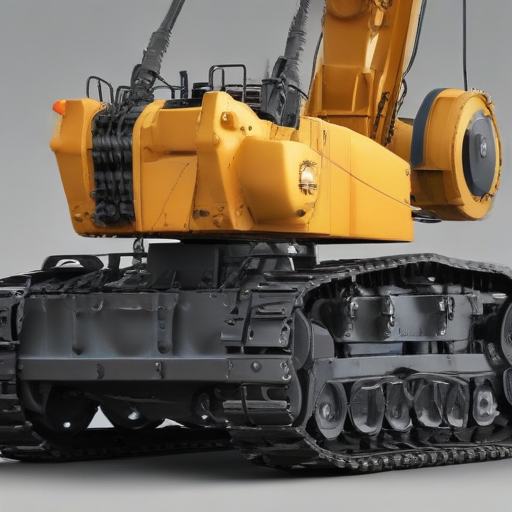
List Product features of “crawler crane”
Crawler cranes are powerful and versatile lifting machines commonly used in construction and heavy lifting industries. Here are some of the key features of crawler cranes:
1. Crawler Tracks: Equipped with large, durable tracks instead of wheels, allowing for stability and mobility on rough or uneven terrain.
2. High Lifting Capacity: Can lift extremely heavy loads, often ranging from several tons to several hundred tons, making them suitable for major construction projects.
3. Telescopic Boom: Often features a telescopic or lattice boom which can be extended to reach significant heights, enhancing the crane’s versatility.
4. 360-Degree Rotation: Capable of full 360-degree rotation, providing flexible operational range without needing to reposition the entire machine.
5. Stability: The wide base and robust design offer excellent stability, even when lifting heavy loads at high elevations.
6. Transportability: While large, many models are designed to be disassembled into manageable components for easier transportation between job sites.
7. Cummins or Caterpillar Engines: Typically powered by high-performance, reliable diesel engines from well-known manufacturers like Cummins or Caterpillar, ensuring durability and efficiency.
8. Operator Cabin: Comes with a comfortable, ergonomically designed operator cabin, often featuring advanced controls, climate control, and safety systems to enhance operator comfort and efficiency.
9. Safety Features: Includes safety features such as load moment indicators, anti-two block systems, and boom angle indicators to prevent accidents and ensure safe operation.
10. Advanced Control Systems: Modern crawler cranes incorporate advanced hydraulic and electronic control systems for precise and efficient operation.
11. Modular Design: Many models offer a modular design for easy assembly and customization according to specific project requirements.
12. Fuel Efficiency: Designed to be fuel-efficient, reducing operational costs and environmental impact.
Crawler cranes are distinguished by their ability to handle heavy loads while remaining stable and maneuverable, making them essential in large-scale construction and industrial projects.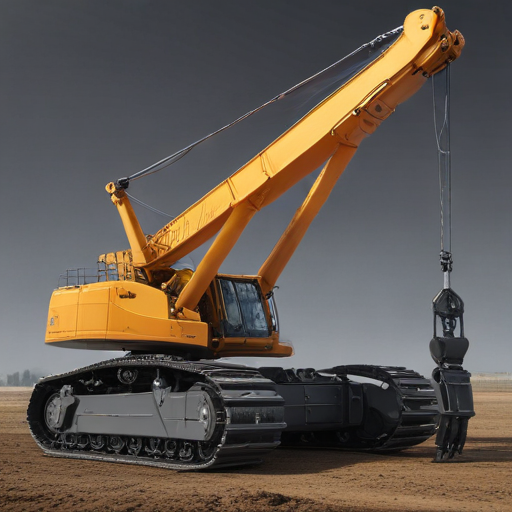
List Various Types of “crawler crane”
Crawler cranes are versatile, heavy-duty lifting machines equipped with tracks (crawlers) for stability and mobility on rough or soft terrain. They are widely used in construction, shipping, and industrial projects. Various types differ in design, capability, and specific use cases. Here are some common types:
1. Lattice Boom Crawler Cranes (LBCC)
– Fixed Lattice Boom Crawler Cranes: Feature a non-adjustable lattice boom for specific lifting tasks.
– Lattice Boom with Luffing Jib: Offers additional reach and flexibility, making it suitable for complex lifts.
2. Telescopic Boom Crawler Cranes
– Standard Telescopic Boom: Highly versatile with a boom that can extend and retract, ideal for varied lifting operations.
– Heavy-Duty Telescopic Boom: Designed for higher capacity lifts, often used in industrial and heavy construction sectors.
3. Mini Crawler Cranes
– Spider Crawler Cranes: Compact and maneuverable, featuring adjustable outriggers and ideal for confined spaces.
– Compact Telescopic Boom: Similar to spider cranes but with a telescopic boom for additional flexibility.
4. Specialized Crawler Cranes
– Duty Cycle Crawler Cranes: Specifically designed for tasks like dragging, piling, and material handling, equipped with robust and durable components.
– Long-Reach Crawler Cranes: Custom-built for operations requiring an extended reach, such as bridge construction and wind turbine erection.
Each type offers unique features suited to specific applications, balancing lifting capacity, reach, maneuverability, and operational flexibility.
List Application of “crawler crane”
Crawler cranes are versatile and powerful machines used for lifting and moving heavy loads in various industries. Here are some key applications:
1. Construction Sites: Crawler cranes are commonly employed in construction projects, including skyscrapers, bridges, and large buildings due to their heavy lifting capacities and ability to navigate rough terrain.
2. Infrastructure Projects: They are essential in infrastructure development such as road construction, railway projects, and airport expansions where heavy components need precise placement.
3. Mining and Quarrying: In mining operations, crawler cranes assist in moving large materials and assembling heavy machinery, playing a crucial role in improving operational efficiency.
4. Marine and Port Operations: Crawler cranes facilitate the loading and unloading of heavy cargo, containers, and oversized equipment from ships, contributing to efficient port logistics and maritime operations.
5. Wind Energy Installations: Their capacity to lift heavy nacelles, rotors, and towers makes them ideal for constructing and maintaining wind turbines, even in challenging environments.
6. Petrochemical Plants: In oil refineries and chemical plants, crawler cranes help in installing and maintaining heavy equipment such as reactors, towers, and vessels.
7. Power Plants: They are used in the construction and maintenance of various types of power plants, including nuclear, thermal, and hydroelectric plants, due to their ability to handle large and heavy components.
8. Demolition: Equipped with wrecking balls or shear attachments, crawler cranes can efficiently demolish large structures.
9. Heavy Industry: They are indispensable for heavy manufacturing sectors, aiding in the assembly and disassembly of large equipment and structures.
10. Entertainment and Events: In some cases, crawler cranes are used for setting up large stages, lighting rigs, and other heavy installations for concerts and major events.
Crawler cranes’ mobility, stability, and high lifting capacity make them invaluable across multiple industries for tasks that require robust and reliable performance.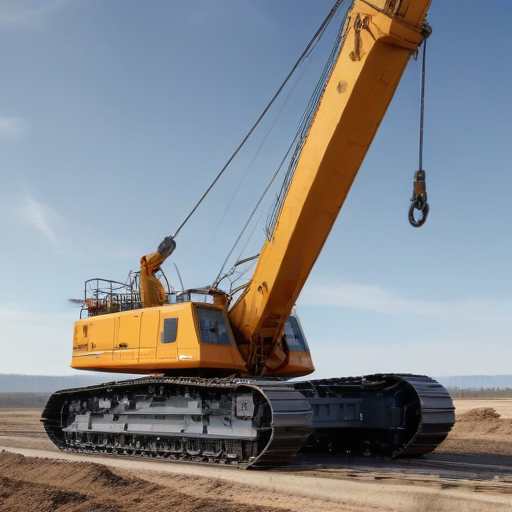
List Buyer Types of “crawler crane”
Crawler cranes are versatile pieces of heavy machinery commonly used in construction and infrastructure projects. Various industries and buyer types typically seek crawler cranes to meet specific operational needs. Here’s a list of the primary buyer types:
1. Construction Companies:
– Large construction firms routinely purchase or lease crawler cranes to assist with building high-rise structures, bridges, and other large-scale projects where heavy lifting and stability are paramount.
2. Infrastructure and Civil Engineering Firms:
– These companies use crawler cranes for public works projects, such as the construction of highways, railways, and airports, due to their ability to handle heavy loads and work on uneven terrain.
3. Oil and Gas Industry:
– In the oil and gas sector, crawler cranes are used for lifting and placing large components during the construction of refineries, pipelines, and offshore rigs.
4. Power and Renewable Energy Companies:
– Companies involved in setting up power plants, wind farms, and solar installations often require crawler cranes for placing heavy equipment like wind turbine parts and other large components.
5. Heavy Manufacturing:
– Factories and facilities that need to move large machinery and assemblies within their production grounds also invest in crawler cranes for internal logistics and heavy lifting tasks.
6. Mining and Quarrying Operations:
– These operations use crawler cranes for excavation, transporting heavy rocks and materials, and infrastructure development within their sites.
7. Port Authorities and Shipping Companies:
– Ports often use crawler cranes for loading and unloading heavy cargo from ships, thanks to their mobility and lifting capacity.
8. Rental and Leasing Companies:
– Firms specializing in renting out heavy equipment maintain a fleet of crawler cranes to cater to the temporary needs of various industries.
Each of these buyer types values the crawler crane’s stability, lifting capacity, and versatility, making it an essential asset in multiple heavy-duty applications.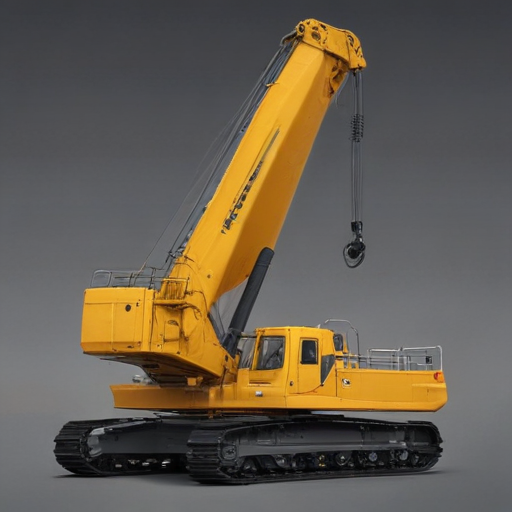
List “crawler crane” Project Types for Different Industries
Crawler cranes are versatile lifting machines mounted on tracks, offering stability and mobility on rough terrain. Their application spans various industries, each with specific project needs. Here are some common project types:
Construction
1. High-Rise Buildings: Erecting steel structures and installing large prefabricated components.
2. Bridge Construction: Lifting heavy girders and placing pre-cast bridge segments.
3. Infrastructure: Setting up large-scale infrastructure elements like highway overpasses and tunnels.
Energy
1. Wind Farms: Installing wind turbine components such as towers, nacelles, and rotor blades.
2. Oil & Gas: Assisting in the assembly and maintenance of drilling rigs and pipelines.
3. Power Plants: Handling large boilers, generators, and cooling tower components.
Industrial Projects
1. Manufacturing Plants: Installing large machinery and production line equipment.
2. Shipbuilding: Assembling ship components including hull blocks and superstructures.
3. Steel Mills: Erecting and maintaining heavy processing equipment.
Mining
1. Surface Mining: Transporting and placing heavy equipment like draglines and crushers.
2. Underground Mining: Construction of deep mining structures and ventilation shafts.
Transportation
1. Railways: Lifting and placing rail track sections, and overhauling rail vehicles.
2. Ports and Harbors: Loading and unloading heavy cargo and container handling.
Renewable Energy
1. Solar Farms: Installing large solar panels and related infrastructure.
2. Hydroelectric Plants: Erecting dam components and heavy turbines.
Dismantling and Demolition
1. Decommissioning Industrial Sites: Removing large sections of old plants.
2. Urban Renewal Projects: Controlled demolition of outdated structures.
Event and Exhibition Setup
1. Stage Construction: Assembling large stages and temporary structures for concerts and events.
2. Large Exhibits: Installing heavy exhibits and showpieces.
Crawler cranes play a critical role in these diverse industries, providing the heavy lifting capability required to accomplish complex projects efficiently and safely.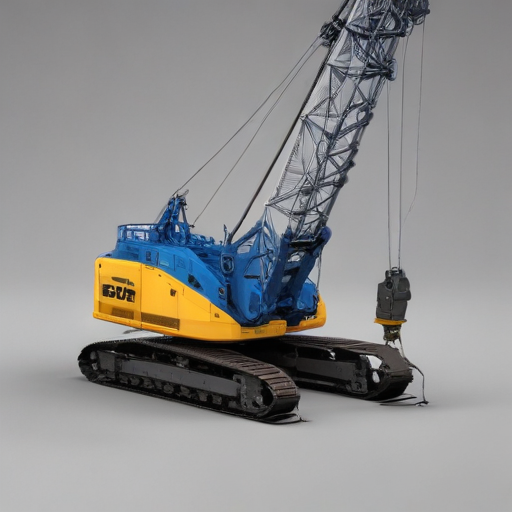
crawler crane Accessories Upgrades and Custom Manufacturing Options
Crawler cranes are versatile and essential pieces of equipment in construction and heavy lifting industries. To maximize their efficiency and adaptability, various accessories, upgrades, and custom manufacturing options are available:
1. Load Monitoring Systems: Advanced load monitoring systems ensure precision and safety, offering real-time data on load weights and operational parameters.
2. Boom Extensions and Jibs: Custom boom extensions and jibs can significantly increase the crane’s reach, enabling more flexibility in diverse operational environments.
3. Winches and Hoists: Upgraded winches and hoists improve lifting capacity and speed, enhancing overall operational efficiency.
4. Safety Enhancements: Integrated safety features such as anti-collision systems, emergency stop mechanisms, and improved visibility cameras can be added to meet specific site safety requirements.
5. Custom Undercarriages: Tailored undercarriage designs can be manufactured to suit varying terrain conditions, providing better stability and mobility.
6. Telematics Systems: Advanced telematics solutions enable remote monitoring and diagnostics, optimizing maintenance schedules and reducing downtime.
7. Auxiliary Power Units: Adding auxiliary power units can support additional functionalities and reduce the main engine’s load, improving fuel efficiency.
8. Special Attachments: Custom attachments, such as clamshell buckets, grapples, and pile drivers, make the crane suitable for specialized tasks.
9. Operator Cab Upgrades: Enhanced cabs with ergonomic seating, climate control, and advanced control interfaces can improve operator comfort and efficiency.
10. Hydraulic System Upgrades: Improved hydraulic systems offer greater precision and smoother operation, essential for handling complex lifts.
Manufacturers and suppliers offer a range of these options to meet the unique needs of specific projects and applications. Investing in these accessories and upgrades not only boosts performance and operational flexibility but also extends the lifespan of the crane, ensuring it remains a valuable asset in your fleet.
List Quality Control and The Manufacturing Process of “crawler crane”
Quality Control in Crawler Crane Manufacturing
1. Raw Material Inspection: Ensure the materials like steel and hydraulics meet quality standards.
2. Component Testing: Examine essential parts like engines, booms, and tracks for defects.
3. In-Process Monitoring: Continuous inspection during assembly to detect and rectify issues early.
4. Non-Destructive Testing (NDT): Utilize techniques like ultrasound or X-rays to check for internal defects without causing damage.
5. Load Testing: Simulate operational conditions to verify the crane’s lifting capacity and stability.
6. Software and Control Systems Verification: Test embedded software for reliable and safe operations.
7. Final Inspection: Comprehensive checks on the fully assembled crane for alignment, safety features, and overall functionality.
8. Certification and Compliance: Ensure compliance with ISO standards and local regulations.
Manufacturing Process of a Crawler Crane
1. Design and Engineering: Create detailed design blueprints and engineering specifications for components and assemblies.
2. Material Procurement: Source high-quality raw materials and specialized components from reliable suppliers.
3. Component Fabrication: Manufacture structural elements like the boom, cab, and undercarriage in-house or through verified subcontractors.
4. Machining and Treatment: Precision machining and surface treatments like heat treating for durability and strength.
5. Welding and Assembly: Weld various structural components, followed by assembling subunits like the track system, cab, and boom.
6. Hydraulic and Electrical Systems Installation: Install hydraulic lines, motors, and electrical wiring, ensuring proper integration with control systems.
7. Assembly Integration: Integrate major assemblies, ensuring proper alignment and fit.
8. Testing and Calibration: Comprehensive testing under simulated operating conditions to validate performance metrics.
9. Painting and Finishing: Apply corrosion-resistant coatings and final paint for durability and aesthetics.
10. Final Quality Assurance (QA) Check: Conduct a final QA inspection, including functional tests and compliance verification.
11. Packaging and Shipping: Prepare the crane for transport, ensuring secure and damage-free delivery.
These processes ensure that each crawler crane is robust, reliable, and safe for various heavy-lifting applications.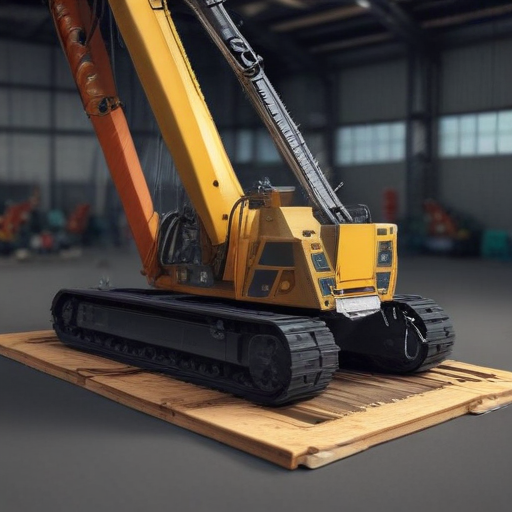
How to use “crawler crane”
Using a crawler crane involves several steps to ensure safe and efficient operation. Here’s a concise guide:
Pre-Operational Checks:
1. Site Assessment: Inspect the worksite for ground stability, obstacles, and overhead hazards.
2. Crane Inspection: Check the crane for any mechanical issues. Ensure all parts, especially tracks, boom, and counterweights, are in good condition.
3. Load Calculation: Determine the weight of the load to ensure it is within the crane’s lifting capacity.
Setup:
1. Positioning: Move the crane to the desired location using its tracks. Ensure the surface is stable and level.
2. Stabilization: Extend the stabilizers or outriggers if available to enhance stability.
3. Boom Assembly: Assemble and extend the boom as required, following the manufacturer’s guidelines.
Operation:
1. Lifting Plan: Develop a lifting plan, specifying the load path, height, and radius of the lift.
2. Communication: Use clear signals or radio communication between the crane operator and the signal person.
3. Lifting: Slowly lift the load, ensuring it is balanced and stable. Keep within safe operating speeds and avoid sudden movements.
4. Movement: If the load needs to be moved to a different location, move the crane cautiously, keeping the load close to the ground and maintaining the balance.
5. Load Placement: Gently lower the load to its designated spot, ensuring it is securely placed.
Shutdown:
1. Retract Boom: Retract and disassemble the boom if necessary.
2. Secure Crane: Turn off the engine and secure the crane against unauthorized use.
3. Maintenance Check: Conduct a post-operation inspection to identify any issues that need addressing.
Safety Measures:
1. Training: Operators must be trained and certified.
2. PPE: Ensure all personnel wear appropriate personal protective equipment (PPE).
3. Emergency Protocols: Be aware of emergency shutdown procedures.
By following these steps, you can safely and efficiently operate a crawler crane.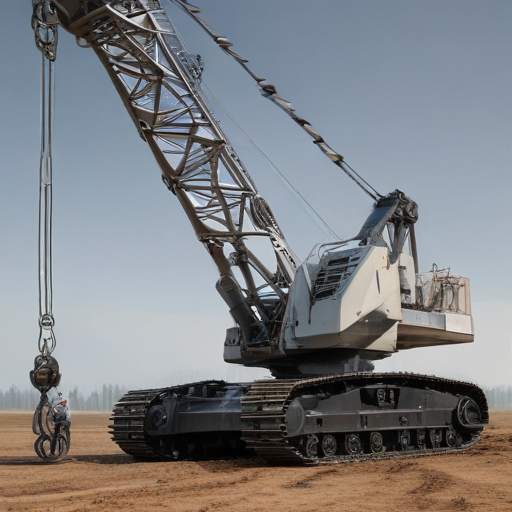
“crawler crane” Comparative Analysis
Crawler cranes are versatile, heavy-duty machines used for lifting and moving heavy loads, primarily in construction and industrial projects. Their key features include a tracked undercarriage, counterweights, and a boom. In a comparative analysis, different models of crawler cranes can be evaluated based on several critical factors:
1. Lifting Capacity:
– High-Capacity Models: These can lift upwards of 1,000 tons, suitable for large infrastructure projects like bridge construction.
– Mid-Range Capacity Models: These typically handle 100-500 tons, ideal for general construction tasks.
– Low-Capacity Models: Best for lighter tasks up to 100 tons, often used in urban construction.
2. Mobility:
– Crawler cranes have tracks instead of wheels, providing superior stability and the ability to traverse rough terrains. However, their speed is slower compared to wheel-mounted cranes.
3. Setup Time:
– Lattice Boom Cranes: These offer higher lifting capacities but require longer assembly times.
– Telescopic Boom Cranes: Faster to set up and dismantle, though generally with lower lifting capacity.
4. Versatility:
– Crawler cranes can handle various tasks, including pile driving and demolition, thanks to interchangeable attachments and booms.
5. Size and Transportability:
– Larger models, while offering greater lift capacities, may require disassembly for transportation, increasing logistical complexity.
– Smaller models can often be transported as a single unit, simplifying logistics but at a cost of reduced lifting capacity.
6. Cost:
– Initial purchase and operational costs can be high. Larger cranes have higher fuel and maintenance expenses. Renting may be a more economical option for short-term projects.
Comparative Example:
– The Liebherr LR 11350 is a high-capacity crawler crane with a 1,350-ton lifting capacity, ideal for wind turbine installation.
– The Kobelco CK1600G-2, a mid-range model with a 160-ton capacity, suits general construction.
– The smaller Link-Belt 75-ton TCC-750 is more suited for urban settings with its ease of transport and setup.
In summary, choosing the right crawler crane entails balancing lifting capacity, mobility, setup time, versatility, size, and cost relative to the specific project needs.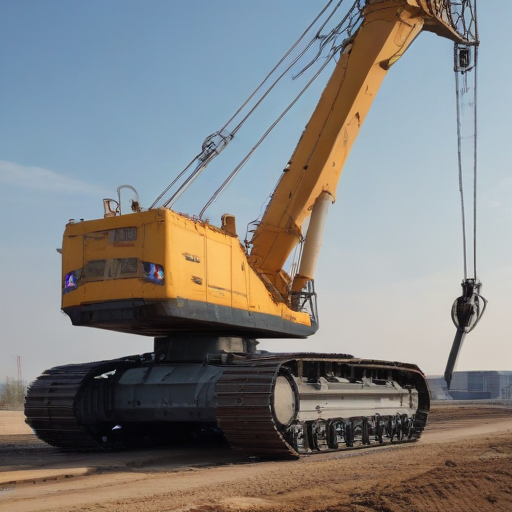
“crawler crane” Warranty and Support
Our crawler cranes come with a comprehensive warranty and support package designed to offer you peace of mind and ensure optimal performance throughout the crane’s lifecycle.
Warranty Coverage:
1. Standard Warranty: Each new crawler crane is backed by a standard 12-month warranty from the date of delivery, covering all major components against manufacturing defects.
2. Extended Warranty Options: Customers have the option to purchase extended warranty plans that can cover up to an additional 24 months. These plans offer extra protection and limit unexpected repair costs.
3. Parts Warranty: Genuine parts used in repairs are warranted for 6 months from the date of installation.
4. Labor Warranty: All authorized service labor is warranted for 90 days from the date of service.
Support Services:
1. 24/7 Customer Support: Our dedicated support team is available round-the-clock to provide immediate assistance via phone or email for troubleshooting and technical queries.
2. On-Site Service: We offer on-site service performed by certified technicians to ensure minimal downtime. These services include routine maintenance, emergency repairs, and component replacements.
3. Training Programs: Comprehensive training programs are available for your operators and maintenance staff to ensure safe and efficient usage of the crane. These include both classroom and hands-on training modules.
4. Spare Parts Availability: A robust inventory of genuine spare parts ensures quick replacements and minimal downtime. We guarantee part availability for a minimum of 10 years after the crane model’s end-of-life.
5. Preventive Maintenance Plans: Tailored preventive maintenance plans help extend the life of your equipment. Our team will work with you to develop a schedule that suits your operational needs and minimizes disruption.
Our commitment to support and service excellence ensures that your crane operates at peak performance, enhancing productivity and reducing total cost of ownership.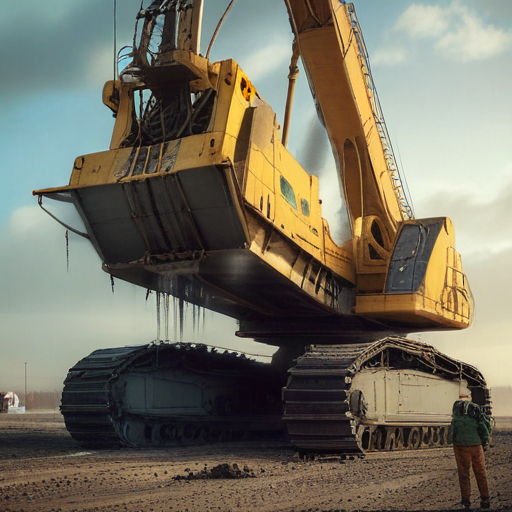
List “crawler crane” FAQ
Crawler Crane FAQ
1. What is a crawler crane?
A crawler crane is a type of mobile crane that has a set of tracks, known as crawlers, instead of wheels. These tracks provide stability and can move on various types of terrain, making the crane suitable for heavy lifting in different environments, including uneven or soft ground.
2. What are the primary components of a crawler crane?
Key components include the crawler tracks, boom, counterweights, engine, and cab. The boom can be latticed or telescopic and is essential for lifting operations. The counterweights help in balancing the crane during lifts.
3. How much weight can a crawler crane lift?
Lifting capacity can range from a modest 50 tons to over 3,500 tons, depending on the model and configuration of the crane. Specific capacity details can be found in the manufacturer’s specifications.
4. What type of terrain can a crawler crane operate on?
Crawler cranes are designed to operate on various terrains including muddy, sandy, and uneven surfaces. The tracks distribute the crane’s weight more evenly, providing greater stability compared to wheeled cranes.
5. Can a crawler crane travel with a load?
Yes, one of the unique features of crawler cranes is their ability to travel with a load. However, the load capacity while traveling is often less than the maximum lifting capacity.
6. What are the common applications of crawler cranes?
Crawler cranes are often used in construction, oil and gas, mining, and heavy industry projects. They are ideal for tasks requiring heavy lifting and moving loads over challenging terrain.
7. How do you transport a crawler crane?
Due to their size and weight, crawler cranes are typically disassembled into smaller components for transport via trucks or trailers. The assembly and disassembly process requires skilled operators and riggers.
8. What is the maintenance requirement of a crawler crane?
Routine maintenance is vital and includes checking tracks, lubricating moving parts, inspecting the boom, and ensuring the engine and hydraulic systems are in good condition. Regular inspections can help preempt any potential issues.
By addressing these FAQs, you can gain a brief yet comprehensive understanding of crawler cranes, their usage, and their features.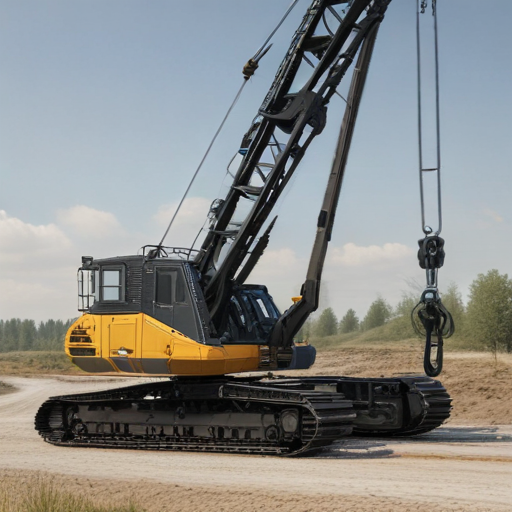
Top 10 FAQ with answer about crawler crane for Buyer Sourcing from China
Certainly! Here’s a concise list of the top 10 FAQs about sourcing crawler cranes from China, tailored for buyers:
1. What are the key factors to consider when sourcing crawler cranes from China?
– Consider quality standards, manufacturer’s reputation, after-sales service, price, customization options, and warranty terms.
2. How can I verify the reliability of a Chinese crawler crane manufacturer?
– Check for certifications like ISO, CE, review customer testimonials or case studies, evaluate financial stability, and inspect manufacturing facilities if possible.
3. What are the common types of crawler cranes available?
– Common types include lattice boom, telescopic boom, and hydraulic crawler cranes. Each type has specific applications and advantages.
4. What is the typical lead time for crawler cranes from China?
– Lead times usually range from 30 to 90 days depending on the model, customization requirements, and current production schedules.
5. Are Chinese crawler cranes compliant with international standards?
– Many Chinese manufacturers comply with international standards like ISO, CE, ANSI, and others. Always verify the specific standards applicable to your region.
6. What are the payment terms commonly offered?
– Common payment terms include a mix of advance and balance payments, often structured as 30% T/T in advance and 70% T/T before shipment or upon receipt of documents.
7. How are spare parts and maintenance services managed?
– Manufacturers generally provide spare parts kits along with the crane. Ensure that the supplier offers comprehensive after-sales service and a clear maintenance schedule.
8. What is the warranty period for a crawler crane?
– Warranty periods typically range from 12 to 24 months but can vary by manufacturer. Confirm what is covered under the warranty.
9. How do I ensure safe transportation and delivery?
– Use experienced logistics companies that handle heavy machinery. Verify that the manufacturer follows proper packing protocols to prevent damage during shipping.
10. Can I get customized solutions for my specific needs?
– Many Chinese manufacturers offer customization to meet specific project requirements. Discuss your needs in detail to get tailored solutions.
By addressing these key questions, you can make a more informed decision when sourcing crawler cranes from China.

